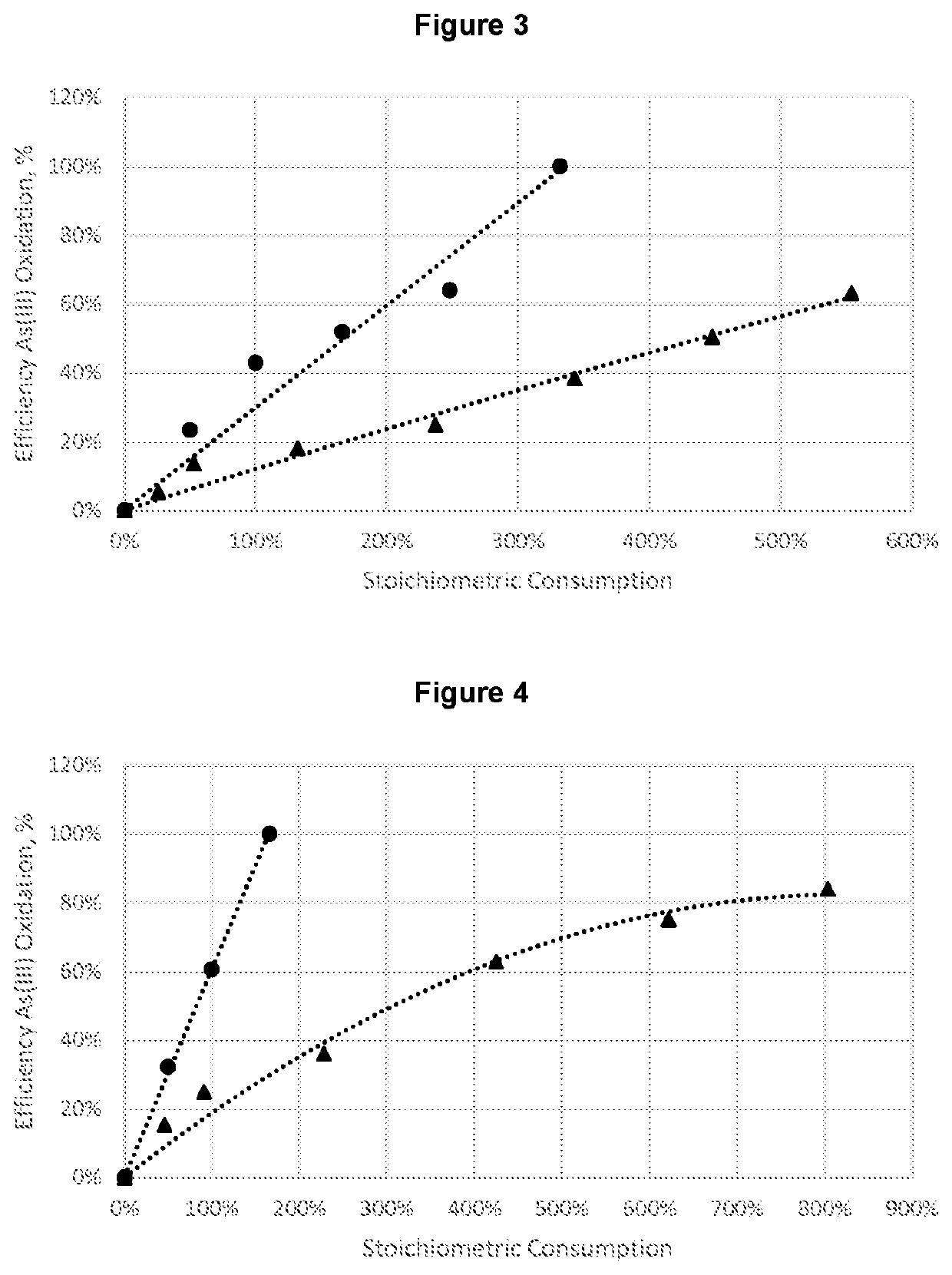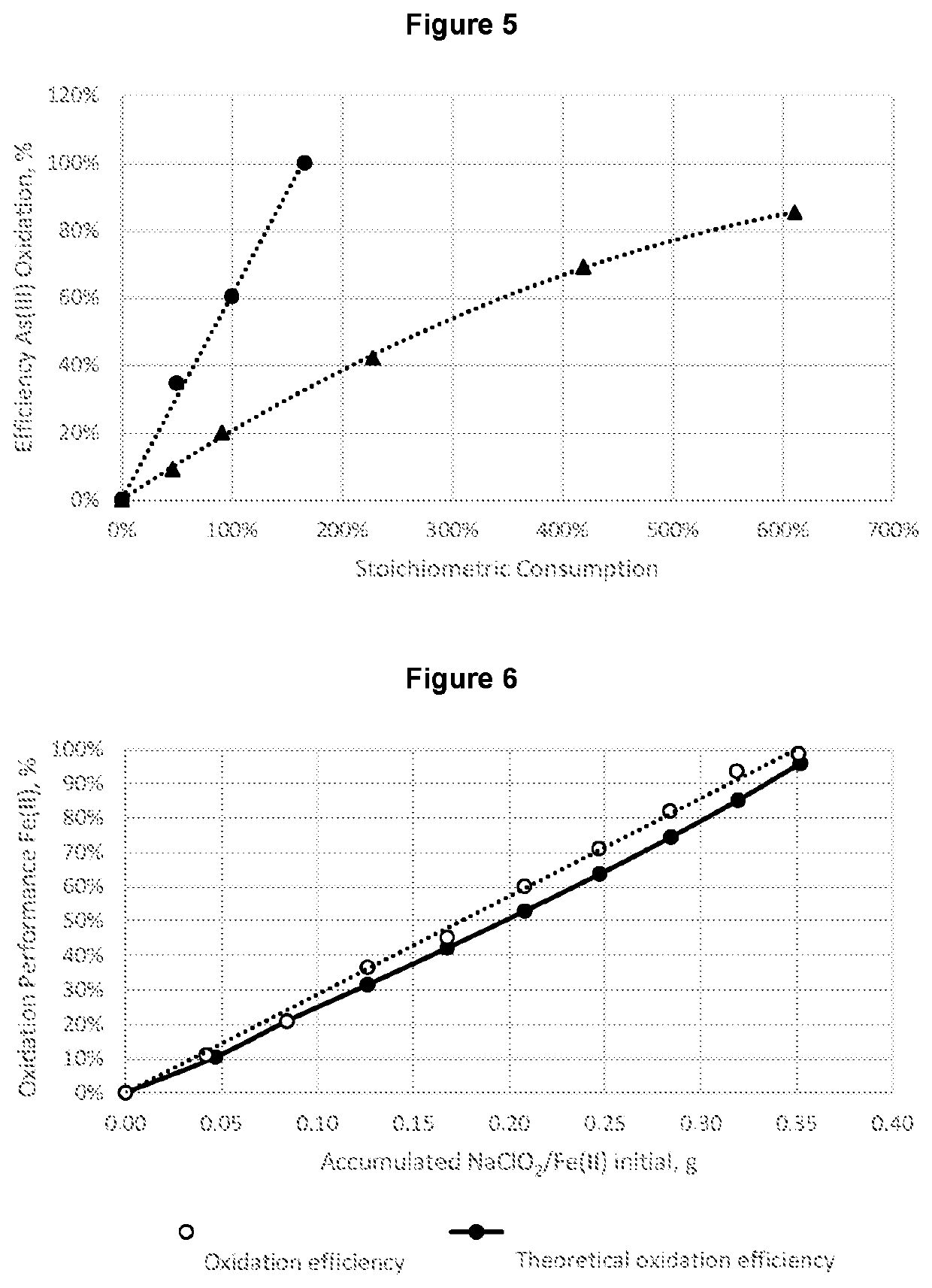Procedure for obtaining scorodite with a high arsenic content from acidic solutions with high content of sulfuric acid
a technology of arsenic content and acidic solution, which is applied in the direction of water/sewage treatment by oxidation, quary waste water treatment, water/gypsum treatment, etc., can solve the problem of reducing the content of arsenic in the solid, generating an excessive amount of gypsum, and not teaching the consumption of oxidant per unit mass ratio of arsenic, and not teaching the remnant of the arsenite ion concentration
- Summary
- Abstract
- Description
- Claims
- Application Information
AI Technical Summary
Benefits of technology
Problems solved by technology
Method used
Image
Examples
example 1
[0060]300 mL were placed in an acid solution containing 55 g / L of sulfuric acid at pH 0.49, with a ferrous ion concentration of 9.27 g / L, a concentration of arsenite ion of 1.93 g / L and a copper concentration of 45 g / L, in a beaker of 500 mL stirring at 300 rpm at room temperature, to which a fixed amount of sodium chlorite was added. The mixture is kept in constant agitation during 30 min and then the concentration of arsenite ion and ferrous ion measured in solution using volumetric analysis with sulphate of cerium(IV) tartrate tetrahydrate 0.1 N from Merck.
[0061]The results of the various tests are presented in Table 1
RatioOxidation efficiency,NaClO2 / Concentration, ppm%As(III) g / gAs3+Fe2+As3+Fe2+Final pH0.481.267.1835%23%0.520.621.146.9541%25%0.550.730.966.7750%27%0.580.900.575.5770%40%0.671.360.374.7481%49%0.761.510.374.0391%57%0.771.660.132.9493%68%0.751.810.092.3595%75%0.761.960.041.4698%84%0.662.110.041.0698%89%0.812.270.040.5598%94%0.763.010.050.5597%94%0.75
example 2
[0062]300 mL of an acid solution containing 55 g / L of sulfuric acid at pH 0.49, with a ferrous ion concentration of 9.27 g / L, a concentration of arsenite ion of 1.93 g / L and a copper concentration of 45 g / L, were placed in a 500 mL beaker stirring at 300 rpm at room temperature, to which a fixed amount of sodium chlorite was added. The mixture is kept in constant agitation during 30 min and then the concentration of arsenite ion and ferrous ion in solution is measured using volumetric analysis with sulphate of cerium(IV) tartrate tetrahydrate 0.1 N from Merck.
[0063]The results of the various tests are presented in Table 2.
RatioNaClO2 / Concentration, ppmOxidation efficiency, %As(III) g / gAs3+As3+0.088.6811%0.306.7431%0.604.7352%0.753.4764%0.923.1967%1.510.4695%2.260.4495%3.020.5295%
example 3
[0064]300 mL of an acid solution containing less than 500 ppm of sulfuric acid at pH 2.85, with a ferrous ion concentration less than 0.55 g / L, a concentration of arsenite ion of 9.76 g / L and a copper concentration of 200 ppm, were placed in a beaker of 500 mL stirring at 300 rpm at room temperature, to which a fixed amount of sodium chlorite was added. The mixture is kept in constant agitation during 30 min and then the concentration of arsenite ion and ferrous ion in solution is measured using volumetric analysis with sulphate of cerium(IV) tartrate tetrahydrate 0.1 N from Merck.
[0065]The results of the various tests are presented in Table 2.
RatioNaClO2 / Concentration, ppmOxidation efficiency, %As(III) g / gAs3+As3+0.215.9726%0.434.2448%0.662.6467%0.890.8090%
PUM
| Property | Measurement | Unit |
|---|---|---|
| concentration | aaaaa | aaaaa |
| concentration | aaaaa | aaaaa |
| molar ratio | aaaaa | aaaaa |
Abstract
Description
Claims
Application Information
 Login to View More
Login to View More - R&D
- Intellectual Property
- Life Sciences
- Materials
- Tech Scout
- Unparalleled Data Quality
- Higher Quality Content
- 60% Fewer Hallucinations
Browse by: Latest US Patents, China's latest patents, Technical Efficacy Thesaurus, Application Domain, Technology Topic, Popular Technical Reports.
© 2025 PatSnap. All rights reserved.Legal|Privacy policy|Modern Slavery Act Transparency Statement|Sitemap|About US| Contact US: help@patsnap.com



